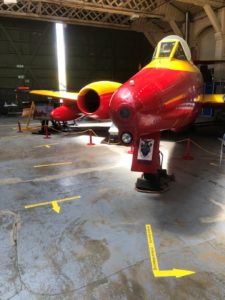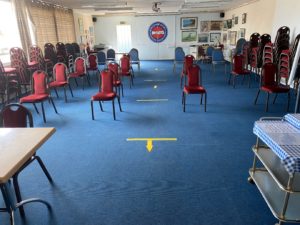We heard from Boscombe Down Aviation Collection in Wiltshire about the process, as they welcomed back visitors on 7th July.
On 4th July 2020, museums and heritage sites were allowed by the Government to reopen.
Below is an account of the considerations the museum made prior to reopening and the changes made to welcome back volunteers and visitors safely.
To date their recent visitor numbers, although significantly lower than usual for this time of year, have been higher than expected with high levels of volunteer re-engagement.
What considerations and new processes have you made for reopening?
-
Risk Assessment – we drafted this early and then regularly reviewed and updated this throughout lockdown and after reopening.
- We created separate procedure documents for different area teams (e.g. Shop Staff, Guides, First Aiders) to ensure that we targeted the considerations to be made without overwhelming everyone with too much information.
- Our volunteers helped test and tweak social distancing guidelines, including pinch-points and placement of sanitiser stations etc.
- We scheduled cleaning rotas and ensuring ongoing supplies of key resources (sanitiser, gloves etc.)
- Completed the ‘Good To Go’ quality mark application – the process revisits and evaluates all arrangements and plans.
What practical changes have you made for reopening?
- Social distancing tape and signage showing one-way route on floors
- Hand sanitiser stations throughout entry and exhibition areas
- Hangar doors open for ventilation
- New entrance area to facilitate safe indoor queuing – separate entry for volunteers
- Some cockpits open to view (those with limited ventilation currently closed)
- Increased cleaning / hygiene regimes for open areas
- Flying helmets and flying suits for visitor use withdrawn
- Children’s play area closed.
- New map available in A3 for visitors to photograph and use on mobile phones during visits.
- Perspex screen installed on the entrance desk
- Welcome screen in entry area with a short explanation from the front of house about safety expectations
How have you managed ticketing?
We considered timed tickets and a booking system, but decided based on normal visitor numbers, and distribution patterns through the week, that we could manage effectively and safely with our existing walk-up arrangements.
We are fortunate to have a really large floor area which gives us a large safe capacity which is far in excess of normal visitor numbers – though we do have a system in place for alerting the duty manager in the event of visitor numbers exceeding 50 at any one time (which would be 25% of our agreed maximum operating capacity at present).
For Track and Trace we’re using a GDPR compliant visitor’s book, and securely recording basic contact details on entry for each party. We’re asking visitors to check out on departure so we can record the time in the track and trace log – in turn this also means we have an accurate picture of current visitor numbers at all times.
How did you communicate and consult with your volunteers?
This has been key for us and we have kept in touch with our volunteers through regular newsletters and updates. Early on during lockdown we received suggestions which helped us to gauge both the expectations and likely numbers of returning volunteers.
We took time to talk to volunteers individually who are at a higher risk, or more concerned, about returning.
All of our information included procedure guides, risk assessment and cleaning schedules, which are available to view on site at the museum.
What sort of training did volunteers receive?
We delivered three internal training sessions, via Zoom open to all. Some plans and processes were adjusted as an outcome from the sessions.
The sessions covered:
- Our process and considerations for our risk assessment
- Meeting visitor expectations
- Responsibilities for visitors and volunteers
- Hygiene and cleaning
- Facilitating positive visitor experiences
- Q&A – a chance to share concerns and ideas.
We also organised walk-around sessions to test routes, ‘pinch-points’, placement of sanitiser stations etc – both to reassure and familiarise volunteers with arrangements, but also to robustly test our arrangements.
How did you share practice with other organisations?
We participated in in group meetings hosted by Aviation Heritage UK (AHUK) with aviation museums across the UK. Here we could share ideas, concerns and find practical solutions to reopening. This proved to be a really useful way of benchmarking our own plans, and meeting visitor expectations. We also joined the reopening discussions with museums across Wiltshire as part of Wiltshire Museums Group.
How did you communicate with potential visitors?
We updated our website – including new photographs to demonstrate the space and visitor flow and created a downloadable PDF visitor guide to show the new arrangements.
We circulated a local press-release to raise awareness that we were reopening and posted updates on our social media to encourage our audiences to find out more on our website and to come and visit us.
What advice might you give to other museums considering reopening in the coming months?
Prepare early:
- Identify and source required items (sanitiser, masks, gloves, social distancing tape/signs)
- Draft your Risk Assessment immediately, then use it as a working document under constant review, as your knowledge grows and the guidance develops. This enabled us to have constructive and focused debate as things changed around us.
- Re-evaluate regularly and make amendments to your processes.
- Our walk-through sessions to test arrangements and training for volunteers gave valuable insight and reassurance.
One volunteer shared their thoughts on the reopening process:
I am personally very impressed and reassured by all the work that has gone on ‘behind the scenes’ since lockdown began to ensure that BDAC is safe for volunteers to get involved with and as always a safe and unique experience for our visitors…. Tremendous thought and care has been put into keeping volunteers and visitors safe at The Collection – well done everyone!!


